

Immigrants and refugees from all over the world have brought their unique, diverse traditions to popular holidays in the United States. Some, like the Swahili names of Kwanzaa candles and the Scottish New Year’s Eve song Auld Lang Syne, have obvious international roots. Others, like mistletoe at Christmas, jack-o-lanterns at Halloween and chocolate bunnies at Easter, may surprise you with their origins. Read on to learn just some of the ways immigration has shaped our celebration of Labor Day, Halloween, Veteran’s Day, Thanksgiving, Hanukkah, Christmas, Kwanzaa, New Year’s Eve and Easter.
Easter
 The story of the Easter Bunny was brought to the United States by German immigrants. The mythical bunny known as an “Oschter Haws” would lay eggs outside the homes of well-behaved children. Children began creating “nests” to encourage egg laying. Later, as the number of gifts left by the bunny increased, the nests evolved into the contemporary Easter basket. Chocolate bunnies, originally handmade in rabbit-shaped molds, were also imported by German immigrants.
The story of the Easter Bunny was brought to the United States by German immigrants. The mythical bunny known as an “Oschter Haws” would lay eggs outside the homes of well-behaved children. Children began creating “nests” to encourage egg laying. Later, as the number of gifts left by the bunny increased, the nests evolved into the contemporary Easter basket. Chocolate bunnies, originally handmade in rabbit-shaped molds, were also imported by German immigrants.
Many traditional Easter treats were brought to the United States by immigrants. Russian American Sam Born founded the candy company that created Peeps, the chick-shaped marshmallow that many children (and some adults) enjoy around Easter time. Another immigrant entrepreneur, Bavarian-born William Schrafft, founded Schrafft’s Candy Company and is credited with the popularization and possibly the invention of the jellybean. Jellybeans themselves are likely a cross between Turkish Delight, a classic Middle Eastern delicacy, and Jordan almonds, an Italian treat with roots in Ancient Rome.
Easter lilies, a flower so associated with the holiday that they share a name, came to the United States from Japan by way of Bermuda. After a Japanese missionary to Bermuda gifted some lily bulbs to a local friend, the plant took off on the island. From there, the beautiful flowers found their way to the United States. Traditionally, the lilies are significant to Easter because their growth from a dormant bulb to a full flower echoes the resurrection of Christ and the return of spring.
Labor Day
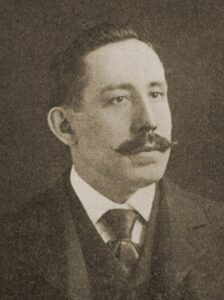
Santiago Iglesias, Spanish-born labor activist and newspaper founder
Labor Day celebrates the proud tradition of the labor movement in the United States. Immigrants have made tremendous contributions to these efforts since the movement began, and foreign-born workers have often formed the backbone of unionization efforts. One example of their early influence is the constitution for the first construction workers union in 1903, which was published in English, German and Italian.
Here are just a few of the many immigrant labor activists and immigrant-led union efforts in United States’ history.
- 1870s – Spurred by personal and financial catastrophes, Irish American Mary Harris “Mother” Jones became a fiery labor leader in middle age to protect others from the struggles she faced.
- 1900 – Eastern European Jewish immigrants launched the International Ladies Garment Workers Union.
- Early 1900s – Throughout the early 1900s, Spanish-born Santiago Iglesias led labor rights activism in Puerto Rico, founding multiple newspapers promoting the cause.
- 1933 – Polish American labor activist Rose Schneiderman became the only woman appointed to the post-Depression National Recovery Administration Labor Advisory Board, where she fought for the rights of women workers.
- 1930s and ’40s – Guatemalan-born Luisa Moreno created pan-Latin American solidarity among workers and built alliances with Black workers.
- 1960s – Mexican American immigrant laborers led farmworker campaigns for better treatment and wages. At the same time, Filipino American labor activists Philip Vera Cruz and Larry Itliong built solidarity with the Mexican American campaigners and ensured Filipino farmworkers would not be left out of the effort.
- 1990 – Salvadoran American janitors led the Justice for Janitors campaign that sparked the modern fight for the $15 minimum wage.
- 1990 – Guatemalan American poultry workers drew on Mayan pride movements to organize their dangerous workplaces.
- 1993 – Guatemalan, Haitian and Mexican American farmworkers launched the Coalition of Immokalee Workers to fight abusive conditions in Florida agriculture.
American labor unions have a spotty history when it comes to immigration issues. Historically, American-born workers exposed to misinformation about immigration and jobs have been pitted against foreign-born workers, and labor union policy has sometimes reflected that. Fortunately, the 21st century has shown more unions embracing all workers, regardless of immigration status, as demonstrated by this statement from the AFL-CIO. Solidarity between different immigrant groups and U.S.-born workers has produced strong results that benefit all workers to this day.
Teachers wanting to share more about immigrants’ impact on early 20th century labor movements should reference our lesson plan bundle on Immigrant Women and the Industrial Revolution.
Halloween
The United States’ spookiest holiday has its roots in an ancient Celtic festival known as “Samhain,” during which people would build bonfires, don animal skins and celebrate the harvest. The Christian holiday All-Soul’s Day, contributed other traditions to Halloween, most notably trick-or-treating. On All-Soul’s Day, poor families in England went door-to-door to beg for “soul cakes” in exchange for a promise to pray for the household’s departed family members. As time went on, the practice evolved to include children from any background going door-to-door in search of treats, money and even ale. All-Soul’s Day, widely observed in England, and Samhain, primarily practiced among Celts, effectively merged to form Halloween.
 Early Protestant immigrants to the United States didn’t approve of the holiday’s mischief-making or pagan connections. It wasn’t until waves of Irish immigrants arrived in the 19th century, particularly in the wake of the Irish Potato Famine, that the holiday gained traction in the United States. Early Irish celebrants of All-Soul’s Day would carry a hollowed turnip with a face carved into it and a candle placed inside to ward off evil spirits. When Irish immigrants reached the New World and gained access to far more easily carved pumpkins, these turnips turned into the modern-day jack-o-lanterns. According to some accounts, the practice of dressing up in costumes began as a ruse among European Christians to confuse wandering spirits. The tradition was revived among young Scottish and English immigrants who wanted to add a little mischief to the festivities.
Early Protestant immigrants to the United States didn’t approve of the holiday’s mischief-making or pagan connections. It wasn’t until waves of Irish immigrants arrived in the 19th century, particularly in the wake of the Irish Potato Famine, that the holiday gained traction in the United States. Early Irish celebrants of All-Soul’s Day would carry a hollowed turnip with a face carved into it and a candle placed inside to ward off evil spirits. When Irish immigrants reached the New World and gained access to far more easily carved pumpkins, these turnips turned into the modern-day jack-o-lanterns. According to some accounts, the practice of dressing up in costumes began as a ruse among European Christians to confuse wandering spirits. The tradition was revived among young Scottish and English immigrants who wanted to add a little mischief to the festivities.
Many popular Halloween candies can be traced to the innovations and confectionary skills of immigrant entrepreneurs. As noted in the section on Easter traditions, both jellybeans and Peeps were invented by immigrant entrepreneurs. Samuel Born, the Peeps inventor, also designed the machine that allowed candy companies to manufacture sweets on a stick. Almond Joy and Mounds bars were created by the Peter Paul Candy Manufacturing Company, a division of Hershey’s that was founded by six immigrants from Armenia. Bunte Candy Company, founded by German American immigrants, is credited with the first chocolate-coated candy bar. Prussian American immigrant entrepreneur Paul F. Beich gets credit for Laffy Taffy, Austrian American Leo Hirschfield created Tootsie Rolls, German American Gustav Goelit sold the first candy corn and English American Edward Dee brought Smarties to the States. In short, whatever your favorite Halloween treat is, you probably have an immigrant to thank for it!
Veteran’s Day
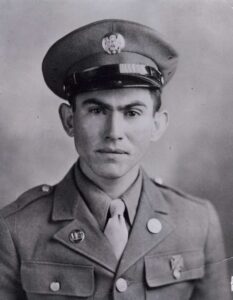
Pedro Cano, a Mexican American WWII veteran who was awarded the Medal of Honor, by Aaron Pena, CC BY-SA 3.0, https://en.wikipedia.org/w/index.php?curid=22874042
Immigrants have a long, impressive history of serving in the United States military. Immigrants’ track record of contributions in this arena dates to the Revolutionary War, when heroes like Prussian American Baron Friedrich von Steuben organized the ragtag American army and English American Thomas Paine wrote influential essays in favor of independence while he fought his former homeland. Perhaps the most famous of these foreign-born heroes is Caribbean American Alexander Hamilton, whose story of immigration, war and triumph was immortalized in the popular musical Hamilton.
Immigrants have been highly represented among military heroes of the 20th and 21st century as well, numbering one in five Medal of Honor recipients. These foreign-born service members’ contributions have not always been recognized. In 2014, President Obama awarded the Medal of Honor to 24 veterans, several of them immigrants, who had previously been denied the honor due to their racial or ethnic backgrounds. One, Mexican American WWII veteran Pedro Cano, was awarded the medal for singlehandedly destroying several Nazi machine guns while under heavy fire. Another, Mexican American veteran Jesus S. Duran, was recognized for risking his life during the Vietnam War to turn back enemy forces, saving the lives of several of his comrades.
One reason immigrants are valuable members of the military is their diverse backgrounds give some immigrant service members language and cultural skills that are more difficult and expensive to develop in U.S.-born Americans. During the Iraq War, for example, the military has actively recruited native Arabic and Farsi speakers, many of them immigrants, to provide vital translation services for military personnel. While wartime has sometimes led to suspicion of foreign-born individuals in the United States, immigrants have made incalculable sacrifices as part of the U.S. armed forces.
Thanksgiving
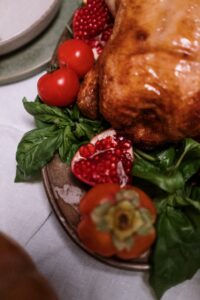
A Thanksgiving turkey prepared with pomegranates demonstrates an Israeli influence on the traditional meal.
Immigrant families have brought many unique twists to the traditional Thanksgiving table. The classic centerpiece turkey has been reinterpreted countless ways. In the industrial age, some manufacturers who employed high numbers of immigrants handed out turkeys before Thanksgiving to encourage the newcomers to embrace the holiday. The birds didn’t come with instructions, so many immigrant families leaned on their culinary backgrounds to create their first American Thanksgiving
Contemporary immigrant families continue to put their own spin on the dish, including Italian American citrus-infused turkeys, Senegalese American tamarind turkeys, Chinese American Peking-style turkeys, Indian American tandoori turkeys, Mexican American chile-flavored turkeys, Lebanese American rice-stuffed turkeys, Cuban American pepper and adobo turkeys and Israeli American walnut and pomegranate turkeys.
Many popular Thanksgiving dishes themselves have immigrant origins. Pecan pie was first concocted by French immigrant chefs in New Orleans. Pumpkin pies fill English pastry shells with a main ingredient native to the United States. Apples were brought to the New World from Europe, as were the Dutch and English recipes for apple pies and French recipes for cider. English Americans are credited with mashed potatoes and immigrants from many European countries brought their nations’ preferred variation on stuffing. Tamales, which have gained prominence in recent years as a festive Thanksgiving side dish, originated in Latin America.
Hanukkah/Chanukah
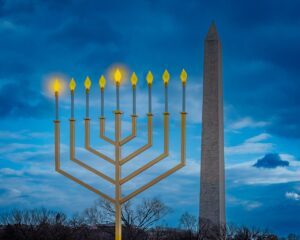
Hanukkah, also known as the Festival of Lights, is an ancient Jewish holiday that commemorates the rededication of a Temple in Jerusalem after winning it back from the Greek occupiers in the second century BCE. Historically Hanukkah had been considered a minor event in the Hebrew calendar, but for modern American Jews, it can be one of the biggest celebrations of the year. The largest waves of Jewish immigration to the United States took place in the late 19th and early 20th centuries, fueled by both economic concerns and an increasingly hostile environment in Europe. New Jewish Americans were eager to show their enthusiasm for their adopted homeland, and the subject of hard-won religious freedom seemed particularly relevant. Hanukkah is now celebrated by millions of Americans each year and has become one of the most valued traditions of North American Jewish communities. The holiday became a perfect opportunity to participate in American holiday-time feasting and gift-giving while keeping their traditions and building stable Jewish communities.
It was also an opportunity to resist forced assimilation. Some rabbis saw emphasizing the Hanukkah holidays, particularly the food and gifts aspects, as an opportunity to keep Jewish children from being drawn into Christmas celebrations. In the mid-20th century, Jewish children were often pressured into celebrating Christmas in their schools. Jewish parents presented Hanukkah as an alternative tradition for their children to participate in.
Food traditionally associated with the holiday varies across Jewish cultures. U.S.-born people may be most familiar with the potato latke, but Jewish Hungarians traditionally fry up a cheesy version. Cheese is associated with the holiday due to the lesser known Hanukkah story of an Israeli woman named Yehudis, who was said to ply the leader of an occupying Assyiran force with salty cheeses to encourage him to drink himself into a vulnerable stupor. Jewish Italians also enjoy a fried or baked cheese pancake, called a “cassola” and made of ricotta. Italian Catholics have since adopted the dessert as a Christmas dish. Jewish Syrians prefer a variation on the latke called “kibbet yatkeen,” containing bulgur and pumpkin. For Jewish Israelis, jam-filled doughnuts called “sufganiyot” has gained popularity over the latke. Some Jewish Indians enjoy “gulab jamun,” a deep-fried, doughnut-like sweet dipped in a sugary syrup. Jewish North Africans make a similar dessert called “debla,” traditionally shaping the dough into a rose. The exact origins of Hanukkah gelt, a type of small, foil-wrapped chocolate coins, are unclear, but it may be linked to a Yemeni tradition of giving Jewish children a coin every day of Hanukkah to buy sweets.
Christmas
 European colonists brought Christmas to North America in the 1600s. Their observations were strictly religious, with few of the treats and trappings familiar to modern Americans. Many of the Christmas traditions that Americans cherish in the 21st century originated elsewhere, were brought here by immigrants and became American as they passed from generation to generation.
European colonists brought Christmas to North America in the 1600s. Their observations were strictly religious, with few of the treats and trappings familiar to modern Americans. Many of the Christmas traditions that Americans cherish in the 21st century originated elsewhere, were brought here by immigrants and became American as they passed from generation to generation.
- In the 1800s, Germanic immigrants brought the traditions of Christmas trees. Christmas trees’ appeal expanded dramatically after the Industrial Revolution allowed for ornaments and special candles to be mass produced in Europe and shipped to the United States. Similarly, gift-giving began as a German tradition and increased in popularity as the price of everyday goods fell.
- Christmas cards were popularized in the U.S. by Louis Prang, a Prussian refugee and artist. After successfully selling his elaborately designed holiday cards in the United Kingdom, he introduced his new product to the United States. He saw his cards as a way to share fine art, as well as a substitute for the more time-consuming tradition of the Christmas letter.
- The classic Christmas tune White Christmas was written by Irving Berlin, a Russian immigrant who practiced Judaism.
- Joel Roberts Poinsett may have been an American diplomat and amateur botanist, but the “flor de la noche buena,” better known as a “poinsettia” in English, was native to Mexico before Poinsett sent cuttings home.
- Mistletoe played a significant role in both Norse and Celtic druidic mythology before evolving into a modern symbol of holiday love.
- Burning a Yule log began as a Scandinavian tradition, meant to bring luck or protection to the family in the coming year. These days, celebrants are more likely to enjoy a “bûche de Noël,” a style of cake shaped and decorated to resemble a Yule log that was popularized by Parisian bakers.
- Saint Nicolaus, or Sinterklaas, as he was known to the German, Dutch, Ukrainian and Swiss immigrants who originally celebrated him, was expected on December 6 not the 24th. He is still celebrated on that date in communities throughout the U.S.
- The first mall Santa, a beloved figure for many children, was created and popularized by Scottish American department store owner James Edgar.
Some communities continue the Christmas celebration into January. After weeks of gatherings and feasts, Christians from South and Central America have a final celebration on January 6 known as Three Kings Day or the Twelfth Day of Christmas. Christians from Egypt, Eritrea, Ethiopia, Greece, Israel, Russia and several other Eastern European countries follow the Julian calendar and therefore celebrate Christmas on January 7.
Kwanzaa
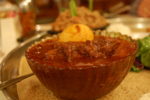
Ethiopian doro wat chicken
Kwanzaa is the newest year-end holiday. It is the only December holiday to start in the United States, and it is now celebrated by millions around the world. It was created in the 1960s to reconnect American descendants of enslaved Africans with their heritage. Unlike other immigrant groups who could choose which aspects of their cultures and histories to preserve and which to let go, African Americans were forced to give up their traditions. After police brutality sparked the Watts uprising in 1965, Black Studies professor Dr. Maulana Karenga was inspired to create an opportunity to bring the Black community together. He researched harvest traditions across Africa to create a pan-African celebration, which became Kwanzaa.
For seven days, observers of Kwanzaa celebrate their heritage and reflect on shared principles. The name comes from the Swahili phrase “matunda ya kwanza,” which means “first fruits of the harvest.” The extra “a” was added to make the word seven letters long, a number with symbolic significance in the tradition. The seven candles in a “kinara” symbolize the “seven principles” that Karenga assigned to each of the seven days of the holiday: Umoja (Unity), Kujichagulia (Self-Determination), Ujima (Collective Work and Responsibility), Ujamaa (Cooperative economics), Nia (Purpose), Kuumba (Creativity) and Imani (Faith).
Traditional Kwanzaa foods are drawn from both African and American Black communities. Groundnut stews from Ghana and “doro wat” chicken from Ethiopia are common, as is soul food or Creole dishes like black eyed peas and jambalaya. The diverse feasts tell the history of Africans and of their descendants in the Americas. On the final day, December 31, celebrants hold a traditional African feast called a “Karamu.” Kwanzaa is a secular holiday and celebrated by people of all spiritual backgrounds alongside other religious traditions. The food, greetings, symbolism and tales shared during Kwanzaa tell a story of forced migration and hard-won rights for African Americans and also build connections to the rich history and cultural traditions of Africa.
New Year’s Eve
 The dawn of each new year is celebrated across the globe. Perhaps the most famous observance, the annual Times Square Ball Drop in New York City, was created by an immigrant. Prior to 1904, New Yorkers celebrated New Year’s Eve with fireworks, a tradition adopted from Chinese New Year celebrations. However, early 20th century fireworks were fast becoming a safety hazard in crowded cities. A solution was offered by Adolph Ochs, a German-born, Jewish newspaper magnate and publisher of The New York Times. Ochs collaborated with the city to start a new, safer tradition at Times Square, which had been renamed in honor of the new Times headquarters. Ochs’ idea took hold, and the ball drop has become the grand finale to New Year’s Eve celebrations ever since. Observers often toast the new year with a fizzy glass of Champagne. Clever French advertisers in the late 1800s attempted to tie the drink to a number of occasions, but it was the association with New Years that stuck. Genuine Champagne was made in the Champagne region of France and imported to the United States for the occasion, often to be sold by French immigrants.
The dawn of each new year is celebrated across the globe. Perhaps the most famous observance, the annual Times Square Ball Drop in New York City, was created by an immigrant. Prior to 1904, New Yorkers celebrated New Year’s Eve with fireworks, a tradition adopted from Chinese New Year celebrations. However, early 20th century fireworks were fast becoming a safety hazard in crowded cities. A solution was offered by Adolph Ochs, a German-born, Jewish newspaper magnate and publisher of The New York Times. Ochs collaborated with the city to start a new, safer tradition at Times Square, which had been renamed in honor of the new Times headquarters. Ochs’ idea took hold, and the ball drop has become the grand finale to New Year’s Eve celebrations ever since. Observers often toast the new year with a fizzy glass of Champagne. Clever French advertisers in the late 1800s attempted to tie the drink to a number of occasions, but it was the association with New Years that stuck. Genuine Champagne was made in the Champagne region of France and imported to the United States for the occasion, often to be sold by French immigrants.
Classic New Year’s song Auld Lang Syne was an import from Scotland by way of Canada. Scottish poet Robert Burns penned the version of the song we know today, drawing on an old Scottish folk tune. The song gained popularity in the British Isles before making the jump across the pond in 1929, when Canadian-born immigrant Guy Lombardo led an orchestra in a televised New Year’s Eve broadcast that concluded with a rendition of the song. It quickly gained popularity across the country. He would go on to end his annual broadcasts with the iconic New Year’s tune for decades after.
And More
Those are only a handful of the ways that American holiday traditions have been influenced by cultures from around the world. You can find out more about less popular celebrations held in immigrant enclaves or how the original New Year’s resolutions were introduced in ancient Babylonia or simply make a point of participating in the many celebrations held in your community. For more information about how to celebrate our diverse history during the holidays, check out some of the resources below.
Celebrate Diversity During the Holiday – ideas and lesson plan for teachers.
Celebrate! Holidays and Anti-Bias Education
